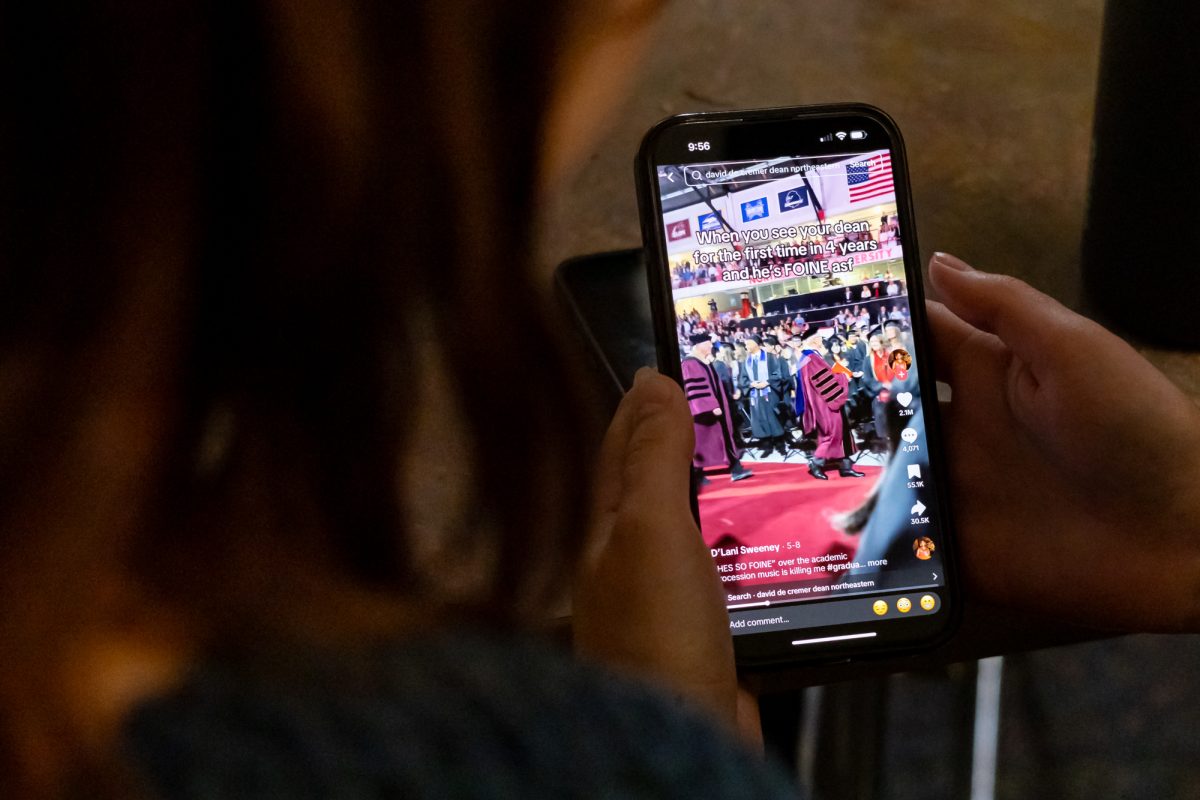Northeastern’s production of William Shakespeare’s “Twelfth Night,” directed by Antonio Ocampo-Guzman, the chair of the department of theatre, finished its 10-day run Nov. 24 at the Studio Theatre in the Curry Student Center. “Twelfth Night” is a romantic comedy about a love triangle, mistaken identity and misunderstandings, and the student cast brought Shakespeare’s prose to life through comedic and musical moments.
“There’s a number of people in this play that are in a world that is sort of topsy-turvy, upside down,” Ocampo-Guzman said. “They’re lost, and they need to find each other.”
The play, one of Shakespeare’s many comedies, explores several storylines, the first centered around Viola (Naomi Kim), a woman shipwrecked in Illyria who disguises herself as a man named Cesario to be able to find work. Along the way, she becomes entangled in the love stories of several other characters.
Running adjacent to Viola’s quest is the story of Duke Orsino (Edwin Johnson), who pines after the Countess Olivia (Gabriela Hernández) — but her eyes wander elsewhere. Curio (Olivia Alberta) and Valentine (Natalie Dion), two of the duke’s attendants, deliver messages amongst the two nobles. Maria (Abby Barton), Countess Olivia’s maid, takes note of the stern nature of Malvolio (Noah Braunstein), the countess’s steward, and concocts a plan to loosen him up, for better or worse.
Sebastian (John Fu), the long-lost brother of Viola, arrives in Illyria with his companion Antonio (Casey Benzing) and is often confused with his twin Viola, at cost to himself, to Antonio and to others. Sir Andrew Aguecheek (Liam Prendergast) spends the play fighting for love, while his friend Sir Toby Belch (Michael Mundia) manages both to be the life of the party and to secure love in the end. The countess’s fool Feste (Ashley DiLorenzo) both opens and closes the play, appearing throughout and connecting the characters to one another, helping to deliver all of these stories to the audience.
Each character has their own evolving storyline, as Braunstein, a fourth-year theatre major, said of his character Malvolio. In search of love, Malvolio performs the most ridiculous tasks that are completely out of character for the Malvolio the audience meets at the start of the play.
“Something I really like about [Malvolio] is how utterly absurd his arc is throughout the play, because when we first meet him, he is very grave,” Braunstein said. “He is entirely put together. He’s the kind of person who makes sure that absolutely everything around him is in its proper place at all times. [Later], he shows up wearing knee high, bright yellow socks, smiling like this ridiculous, almost creepy smile, dancing around … and playing that is probably my favorite part of the show.”
“Twelfth Night” can be an uncomfortable watch due to the series of misunderstandings that unfold, but was also made comfortable for the audience because of the environment that the characters created. Feste, for instance, acted as an omniscient narrator who the audience realizes knows more about the goings-on and character dynamics than they might expect from a fool. Feste is the glue of the show, acting as a bridge between the passionate yet scattered emotions of the other characters and the storytelling that the audience receives.
Justin Lahue, the production’s scenic designer, said “the play itself has a lot of really rich, comical and powerful elements,” but that the most exciting part is the way that Ocampo-Guzman’s vision has allowed the cast and crew to create an “intimate atmosphere” that the story can “blossom out of.”
“There is a verb that keeps appearing in many parts of the play,” Ocampo-Guzman said. “That verb is to sway, to go from one thing to the other, to its opposite. And I think that this play is so much about that swaying, you know. You think it’s comedy, then it’s really sad, then it’s really funny, then it’s really absurd, then it’s really violent. And that constant swaying reminds me of how life is. … It’s never one thing.”
The play used its details to represent the real ups and downs of life. It related to its audience using anachronisms: there are incorporated aspects of life that are modern, and perhaps nostalgic to the audience, such as tie-dye and rainbow accessories, Converse shoes and even unexpected references to 2010s music sprinkled throughout.

The original score was composed entirely by DiLorenzo, a fourth-year media and screen studies and theatre combined major and the director of music for the production. “It’s been a really large feat that I’ve undertaken this semester, and I’m very proud of the work that everyone’s put into it and how it’s been sounding,” DiLorenzo said.
Alongside this role, DiLorenzo played the character of Feste, the onstage manifestation of her compositions. As Feste, DiLorenzo sang and played the piano throughout the play, as did Mundia in the role of Sir Toby Belch. All of the music was played and sung by the cast while in character, and each song was tailored to the personality of the character performing it and of the scene. The music felt incredibly personal and spoke directly to the audience, pulling them into the experience with the characters.
“I get to go on stage and be filled with joy, magic and fun,” DiLorenzo said. “Because of how much labor I’ve put into this piece, to have the output just be [to] walk on stage and have a good time is really, really serendipitous.”
Tuscan, Moroccan and Spanish architecture styles influenced the show’s set, with yellow wallpaper spotted with hanging flower plants surrounding the audience. The main set piece was a tiled pool in the center of the stage, which various characters interact with, whether that is through standing on its edge or floating fingers through the water. This pool, Lahue said, serves as a space where the characters are “coming together and then pulling apart.”
The pool “does a wonderful thing of bringing us all together,” Lahue said, but at the same time, it helps advance the narrative in scenes where “you’ve got people at either end [of the pool] that are separated by it.”
In all aspects of Northeastern’s production of “Twelfth Night,” it is apparent the audience is an important part of the production. The stage is placed in the center of wrap-around, black box-style seating, and elements of the set, such as tree vines and lamps, reach over the seats. The cast interacts directly with audience members with focused eye contact, at times handing front-row members props and sitting next to them in the audience.
Talking about the moment when he realized that the play was going to be great, Lahue said, “We’re almost not quite there, because the last piece is the audience. So we’ve created a space, and now we just need to fill it. And I think once that is full is when we will reach that true moment.”










